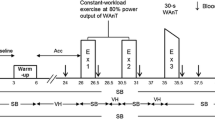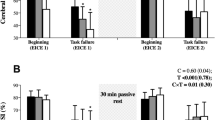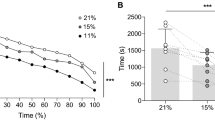Abstract.
The present study examined the effect of hyperoxia on oxygen uptake (V˙O2) and on maximal oxygen uptake (V˙O2max) during incremental exercise (IE) and constant work rate exercise (CWRE). Ten subjects performed IE on a bicycle ergometer under normoxic and hyperoxic conditions (30% oxygen). They also performed four 12-min bouts of CWRE at 40, 55, 70 and 85% of normoxic V˙O2max (ex1, ex2, ex3 and ex4, respectively) in normoxia and in hyperoxia. V˙O2max was significantly improved by 15.0 (15.2)% under hyperoxia, while performance (maximum workload, W max) was improved by only +4.5 (3.0)%. During IE, the slope of the linear regression relating V˙O2 to work rate was significantly steeper in hyperoxia than in normoxia [10.80 (0.88) vs 10.06 (0.66) ml·min–1·W–1]. During CWRE, we found a higher V˙O2 at ex1, ex2, ex3 and ex4, and a higher V˙O2 slow component at ex4 under hyperoxia. We have shown that breathing hyperoxic gas increases V˙O2max, but to an extent that is difficult to explain by an increase in oxygen supply alone. Changes in metabolic response, fibre type recruitment and V˙O2 of non-exercising tissue could explain the additional V˙O2 for a given submaximal work rate under hyperoxia.
Similar content being viewed by others
Author information
Authors and Affiliations
Additional information
Electronic Publication
Rights and permissions
About this article
Cite this article
Prieur, .F., Benoit, .H., Busso, .T. et al. Effects of moderate hyperoxia on oxygen consumption during submaximal and maximal exercise. Eur J Appl Physiol 88, 235–242 (2002). https://doi.org/10.1007/s00421-002-0707-0
Accepted:
Issue Date:
DOI: https://doi.org/10.1007/s00421-002-0707-0




